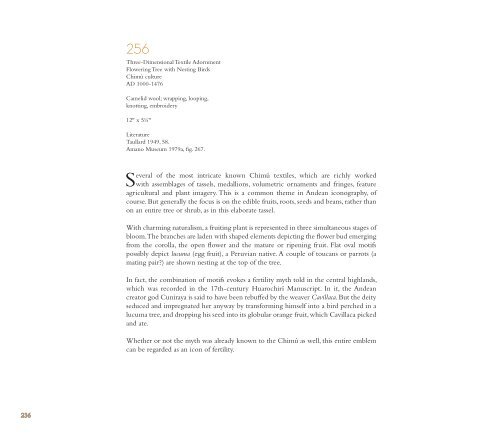You also want an ePaper? Increase the reach of your titles
YUMPU automatically turns print PDFs into web optimized ePapers that Google loves.
256<br />
Three-Dimensional Textile Adornment<br />
Flowering Tree with Nesting Birds<br />
Chimú culture<br />
AD 1000-1476<br />
Camelid wool; wrapping, looping,<br />
knotting, embroidery<br />
12" x 5½"<br />
Literature<br />
Taullard 1949, 58.<br />
Amano Museum 1979a, fig. 267.<br />
Several of <strong>the</strong> most intricate known Chimú textiles, which are richly worked<br />
with assemblages of tassels, medallions, volumetric ornaments and fringes, feature<br />
agricultural and plant imagery. This is a common <strong>the</strong>me in Andean iconography, of<br />
course. But generally <strong>the</strong> focus is on <strong>the</strong> edible fruits, roots, seeds and beans, ra<strong>the</strong>r than<br />
on an entire tree or shrub, as in this elaborate tassel.<br />
With charming naturalism, a fruiting plant is represented in three simultaneous stages of<br />
bloom. The branches are laden with shaped elements depicting <strong>the</strong> flower bud emerging<br />
from <strong>the</strong> corolla, <strong>the</strong> open flower and <strong>the</strong> mature or ripening fruit. Flat oval motifs<br />
possibly depict lucuma (egg fruit), a Peruvian native. A couple of toucans or parrots (a<br />
mating pair?) are shown nesting at <strong>the</strong> top of <strong>the</strong> tree.<br />
In fact, <strong>the</strong> combination of motifs evokes a fertility myth told in <strong>the</strong> central highlands,<br />
which was recorded in <strong>the</strong> 17th-century Huarochirí Manuscript. In it, <strong>the</strong> Andean<br />
creator god Cuniraya is said to have been rebuffed by <strong>the</strong> weaver Cavillaca. But <strong>the</strong> deity<br />
seduced and impregnated her anyway by transforming himself into a bird perched in a<br />
lucuma tree, and dropping his seed into its globular orange fruit, which Cavillaca picked<br />
and ate.<br />
Whe<strong>the</strong>r or not <strong>the</strong> myth was already known to <strong>the</strong> Chimú as well, this entire emblem<br />
can be regarded as an icon of fertility.<br />
236







